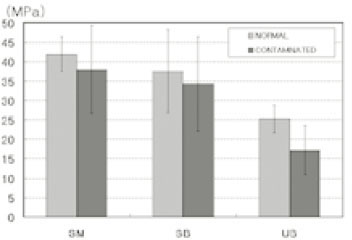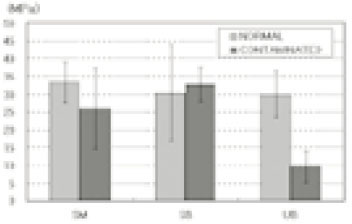J Korean Acad Conserv Dent.
2003 May;28(3):203-208. 10.5395/JKACD.2003.28.3.203.
Effect of salivary contamination of teeth on microtensile bond strength of various dentin bonding systems
- Affiliations
-
- 1Department of Conservative Dentistry, College of Dentistry, Kyung-Hee University, Korea. choikkyu@khu.ac.kr
- KMID: 2175581
- DOI: http://doi.org/10.5395/JKACD.2003.28.3.203
Abstract
- The purpose of this study was to evaluate the effect of salivary contamination of teeth on bonding efficacy of self-priming and self-etching DBSs. The materials used were Single Bond(SB, self-priming system, 3M), Unifil Bond(UB, self-etching system, GC), and Scotchbond Multi-Purpose Plus(SM, 3M) as control. Forty five human molars randomly allocated to three groups as dentin bonding systems tested and embedded in epoxy resin. Then the specimens were wet-ground to expose flat buccal enamel surface or flat occlusal dentin surface and cut bucco-lingually to form two halves with slow speed diamond saw. One of them was used under non-contamination, other under contamination with saliva. The bonding procedure was according to the manufacturer's directions and resin composite(Z-100, 3M Dental Products, St. Paul, MN) was built-up on the bonded surface 5mm high. The specimens were ground carefully at the enamel-composite interface with fine finishing round diamond bur to create an hour-glass shape yielding bonded surface areas of 1.5+/-0.1mm2. The specimens were bonded to the modified microtensile testing apparatus with cyanoacrylate, attached to the universal testing machine and stressed in tension at a CHS of 1mm/min.. The tensile force at failure was recorded and converted to a tensile stress(MPa). Mean values and standard deviations of the bond strength are listed in table. One-way ANOVA was used to determine significant difference at the 95% level. The bond strength of SBMP and SB were not affected by salivary contamination, but that of UB was significantly affected by salivary contamination. These results indicate that DBSs with total etch technique seems less likely affected by salivary contamination in bonding procedure.
Keyword
MeSH Terms
Figure
Reference
-
1. Buonocore MG. A simple method of increasing the adhesion of acrylic filling materials to enamel surfaces. J Dent Res. 1955. 34:849–853.
Article2. Buonocore MG. Retrospections on bonding. Dent Clin North Am. 1981. 25(2):241–255.3. Prati C, Pahsley DH, Montanari G. Hydrostatic intrapulpal pressure and bond strength of bonding systems. Dent Mater. 1991. 7:54–58.
Article4. Perinka L, Sano H, Hosoda H. Dentin thickness, hardness, and Ca+ concentration vs. bond strength of dentin adhesives. Dent Mater. 1992. 8:229–233.
Article5. Bowen RL. Bonding of restorative materials to dentine: the present status in the United States. Int Dent J. 1985. 35:155–159.6. Asmussen E. Clinical relevance of physical, chemical, and bonding properties of composite resins. Oper Dent. 1985. 10:61–73.7. Johnson GH, Powell LV, Gordon GE. Dentin bonding systems: a review of current products and techniques. J Am Dent Assoc. 1991. 122:34–41.
Article8. Pashley DH, Sano H, Ciucchi B, Yoshiyama M, Carvalho RM. Adhesion testing of dentin bonding agents: A review. Dent Mater. 1995. 11:117–125.
Article9. Sano H, Shono T, Sonoda H, Takatsu T, Ciucchi B, Carvalho R, Pashley DH. Relationship between surface area for adhesion and tensile bond strength - Evaluation of a micro-tensile bond test. Dent Mater. 1994. 10:236–240.
Article10. Griffith AA. The phenomena of rupture and flow in solids. Philos Trans R Soc Lond A. 1920. 221:168–198.11. Hormati AA, Fuller JL, Denehy GE. Effects of contamination and mechanical disturbance on the quality of acid-etched enamel. J Am Dent Assoc. 1980. 100:34–38.
Article12. Thomson JL, Main C, Gillespie FC, Stephen KW. The effect of salivary contamination on fissure sealant-enamel bond strength. J Oral Rehabil. 1981. 8:11–18.
Article13. Silverstone LM, Hicks MJ, Featherstone MJ. Oral fluid contamination of etched enamel surfaces: an SEM study. J Am Dent Assoc. 1985. 110:329–332.
Article14. Barghi N, Knight GT, Berry TG. Comparing two methods of moisture control in bonding to enamel : a clinical study. Oper Dent. 1991. 16:130–135.15. Pashley EL, Tao L, Mackert JR, Pashley DH. Comparison of in vivo vs. in vitro bonding of composite resin to the dentin of canine teeth. J Dent Res. 1988. 67(2):467–470.
Article16. Johnson ME, Burgess JO, Hermesch CB, Buikema DJ. Saliva contamination of dentin bonding agents. Oper Dent. 1994. 19(6):205–210.17. Fritz UB, Finger WJ, Stean H. Salivary contamination during bonding procedures with a one-bottle adhesive system. Quintessence Int. 1998. 29(9):567–572.18. Hansen EK, Munksgaard EC. Saliva contamination vs. efficacy of dentin-bonding agents. Dent Mater. 1989. 5(5):329–333.
Article19. Hitmi L, Attal JP, Degrange M. Influence of the time-point of salivary contamination on dentin shear bond strength of 3 dentin adhesive systems. J Adhes Dent. 1999. 1:219–232.
- Full Text Links
- Actions
-
Cited
- CITED
-
- Close
- Share
- Similar articles
-
- The comparison of microtensile bond strength with immediate and delayed dentin sealing
- The effect of various bonding systems on the microtensile bond strength of immediate and delayed dentin sealing
- Influence of air abrasion and different dentin sealing techniques on microtensile bond strength to dentin
- Effect of an intermediate bonding resin and flowable resin on the compatibility of two-step total etching adhesives with a self-curing composite resin
- The effect of adhesive thickness on microtensile bond strength to the cavity wall



